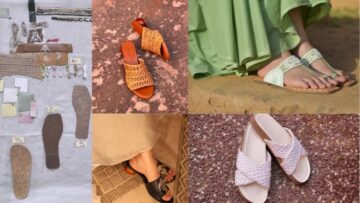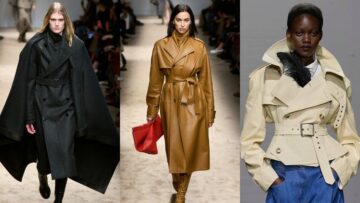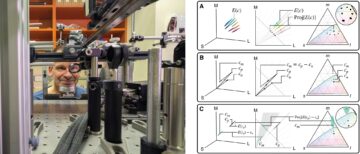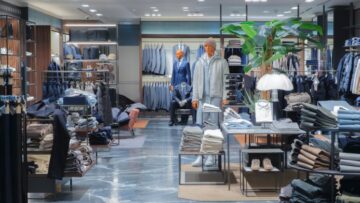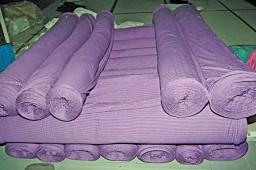
We speak of “shading” when the dyed colour doesn’t match our expectations derived from the original sample, or when the shade achieved varies within the same batch or from batch to batch. If such panels are brought together during apparel manufacturing and end up in one garment, front and back panels might not match and neither will collars and sleeves. The garment cannot be sold.
Dye house managers still can impress by simply taking a look at such shade variations and seemingly come up with a remedy almost instantaneously. But shouldn’t there be a more scientific approach toward not only rectifying such problems but, above all, pre-empting them?
In the automotive industry, shading is probably the major quality factor. Imagine this real scenario from Europe, where an automotive textile supplier dyes his interior fabrics in Austria. These are then cut and made up into roof lining, pillar garnish, sun visors and small items, such as vanity mirrors. The complication is that the various stitching plants that cut and sew these various components are scattered all over Europe, from the Czech Republic right down to Romania. Geographical distance alone precludes that a complete set of cabin items made from one batch of fabrics can ever end up in one and the same car. Thus, absolute shade consistency is the top priority. And it is not an issue, even with these very fabrics ending up in absolute premium vehicles, such as the Mercedes-Benz S-Class.
Tell the above story to apparel manufacturers, and the reaction is often disbelief.
Reasons for Shading
There are dozens of reasons why shading issues occur:
- Variation in dyeing recipes between batches
- Poor lab-to-bulk correlation
- Dyeing machine issues
- Logistics
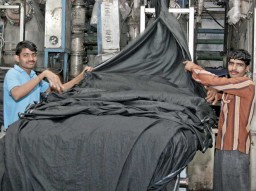
Whilst variation between batches and poor lab-to-bulk correlation will mainly lead to shading between different lots or even rolls of fabric, dyeing machine issues will mainly result in shading within a roll. This could manifest itself, e.g. by shade differences between one side and another of the same piece of fabric.
Shading can, of course, occur during any dyeing process, be it jigger, beam dyeing, HT jet dyeing and yarn dyeing. Every process has its own specific pitfalls with regard to shading – in beam dyeing, for instance, shading can happen as a result of poor beam winding rather than of any dyeing process issue.
Thus, our present focus is mainly on reactive dyeing, given the dominance of cotton dyeing in India. Here, apart from using quality dye stuffs and chemicals, dosing and timing of the latter can have a major impact on shading within a batch. These problems will become even more pronounced once viscose is dyed.
Variation in Dyeing Recipes
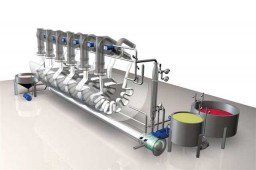
This occurs when dyers change the ingredients in their recipe. They might choose to change from one dye stuff brand to another because of price reasons or simply because they have run out of one or more products used in the original recipe. If that happens, the correct procedure is to first dye a lab sample to verify that the resulting shade is still identical, but time often gets in the way of this procedure.
Poor Lab-to-bulk Correlation
In theory, a long-term statistical evaluation of lab-to-bulk correlation should be kept for every machine in the dye house, as different liquor ratios render different hydrolisation effects. Higher liquor ratios cause dye stuffs and chemicals to lose their efficiency, whilst modern machines (such as AIRFLOW) dye cotton with a dry liquor ratio of only 1:3.75. Unless the lab works with low liquor ratio beaker dyeing equipment in the first place, transferring a lab recipe unaltered to an AIRFLOW machine will result in deeper shades.
Dyeing Machine Issues

Today’s engineering prowess and controller technology allow not only for multi-chamber dyeing machines to produce identical shades in all chambers, but also for an exact shade match from machine to machine, and from batch to batch even from multiple machines. However, this sweeping statement has to be seen against the background of the liquor ratio applied, as more water in the dye process literally “waters down” the efficiency of chemicals and dye stuffs. The more water in the process, the less predictable the actual effect of hydrolisation becomes. This is why modern dye houses are switching to machines with liquor ratios of 1:4 or less (for cotton fabrics). These machines, commonly known as AIRFLOW machines, also increase the efficiency of dye stuffs by some 5%.
Also related to dyeing machines is a commonly encountered (and almost unbelievable) situation, where dye houses operate with either insufficient amounts of steam to heat their dyeing vessels or face multiple power interruptions. Both occurrences lead to the dyeing process being unnecessarily and uncontrollably delayed.
For instance: A modern piece dyeing machine will dye a 100% single cotton jersey to a wonderful maroon colour in less than 280 minutes. This includes all loading and unloading operations, pre-bleaching, dyeing, washing off and rinsing. Due to poor boiler and power systems, outdated dye houses are taking 8 hours for the same job, some even more, and in doing so totally ignoring the fact that this is the 21st century.
Another area of dyeing machine-related shading is, of course, when shading occurs across a single piece of fabric, say from selvedge to selvedge. In this case, both mechanical and chemical reasons can be at work; sometimes it is as simple as poor levelling as a result of inappropriate volume and timing of dosing chemicals or as complex as the geometry of the nozzle of the dyeing machine.
Logistics
[bleft]There is a growing trend among apparel manufacturers towards backward integration into dyeing. This reflects the widespread frustration at having to deal with dye quality issues[/bleft]
There is a growing trend among apparel manufacturers towards backward integration into dyeing. This reflects the widespread frustration at having to deal with dye quality issues (more often than not, shading) resulting from having dyeing performed by commission dyers, whose processes and equipment cannot be directly controlled. This problem is exacerbated when large batches that exceed the capacity of one commission dyer have to be processed at multiple dye houses to meet shipping deadlines. In these unfavourable situations, all the issues described above come together at once and can cause a truly unmanageable crisis to develop.
What Practical Solutions are there?
Clearly, the most effective way to control shading issues is to have the dyeing process under direct control, meaning within your own corporate processing line. This allows not only immediate intervention in the event of any problems arising, but – more importantly – a long-term and successful approach to quality management in the dye house.
If this is not an option, then a very close working relationship needs to be established with a few select commission dyers, bringing the quality management aspect to a level that is almost as good as in the case of in-house dyeing. This must include very fundamental issues, such as the insistence of the customer that only state-of-the-art, low liquor ratio dyeing machines are used in combination with adequate steam and power supply, as this type of equipment already eliminates variation as a result of hydrolisation and offers shortest and most economical dyeing cycles.
Most apparel factories will protect themselves against fabrics with shading issues by stipulating a strict tolerance level (defined and measurable with commercial colour matching systems). In practice, of course, the element of time enters the equation, at times making it impossible to return a shipment of fabric. In such a case, the only practical escape exit is to manually review each and every roll of fabric and to try and match up the most suitable fabrics with each other. In large operations, where electronic fabric laying and cutting is in use, this is, of course, an almost impossible task to contemplate. The simple truth is here, as everywhere: prevention is far preferable to any cure.
More and more apparel manufacturers are recognizing the importance of gaining control over the fabric dyeing process. Ideally, they will establish their own dye houses to achieve this goal. By selecting most modern technology, they will also be able to reduce their per-kg cost of dyeing by around Rs. 9.00 under most conditions prevailing in India. In China, the trend towards state-of-the-art dyeing machinery has already taken off, with sales of AIRFLOW dyeing machines overtaking those of conventional hydraulic machines since 2008.


